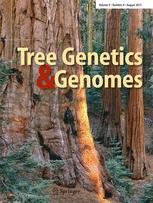Ver ítem
- xmlui.general.dspace_homeCentros Regionales y EEAsCentro Regional Patagonia NorteEEA BarilocheArtículos científicosxmlui.ArtifactBrowser.ItemViewer.trail
- Inicio
- Centros Regionales y EEAs
- Centro Regional Patagonia Norte
- EEA Bariloche
- Artículos científicos
- Ver ítem
Pattern of natural introgression in a Nothofagus hybrid zone from South American temperate forests
Resumen
Interspecific gene flow is a common phenomenon in Nothofagaceae species; however, the dynamics of introgression in hybrid zones remains largely unknown. We focused on two ecologically and morphologically different Nothofagus species from Patagonia, Nothofagus nervosa and Nothofagus obliqua. In a natural hybrid zone, we established two plots 280mapart in altitude (ca. 1.9 °C difference in mean temperature), and two subplots which captured microsite
[ver mas...]
Interspecific gene flow is a common phenomenon in Nothofagaceae species; however, the dynamics of introgression in hybrid zones remains largely unknown. We focused on two ecologically and morphologically different Nothofagus species from Patagonia, Nothofagus nervosa and Nothofagus obliqua. In a natural hybrid zone, we established two plots 280mapart in altitude (ca. 1.9 °C difference in mean temperature), and two subplots which captured microsite variation (abundance and spatial distribution of species and predominance of wind direction). We used intensive sampling of individuals (2055, including adults and regeneration) and molecular genotyping of 6 highly species-specific nuclear microsatellites for the identification and classification of hybrids, based on estimates of ancestry and interclass heterozygosity.
We evaluated the relative contribution of our sampling effects to variation in hybrid incidence and direction of introgression using generalized linear mixed effects models. We determined that introgressive hybridization occurs at a global rate of 7.8% and that variation was mostly explained by plots (frequency at low altitude was approximately twice that found at high altitude), while it was less influenced by subplots. The high altitude plot was dominated by late-generation backcrosses to N. obliqua (asymmetric bimodality), whereas the low altitude plot consisted of intermediate hybrids (unimodality) and showed asymmetry for introgression between subplots. Differences were not detected between adults and regeneration, suggesting early-acting reproductive isolating
barriers. F1 hybrids occur at a global frequency of 3.8%, and are fertile, as the detection of first- and late-generation hybrids indicates.
[Cerrar]

Fuente
Tree Genetics & Genomes 13 : 49 (April 2017)
Fecha
2017-03-29
Editorial
Springer-Verlag Berlin Heidelberg
ISSN
1614-2942
1614-2950
1614-2950
Formato
pdf
Tipo de documento
artículo
Palabras Claves
Derechos de acceso
Restringido
 Excepto donde se diga explicitamente, este item se publica bajo la siguiente descripción: Creative Commons Attribution-NonCommercial-ShareAlike 2.5 Unported (CC BY-NC-SA 2.5)
Excepto donde se diga explicitamente, este item se publica bajo la siguiente descripción: Creative Commons Attribution-NonCommercial-ShareAlike 2.5 Unported (CC BY-NC-SA 2.5)

